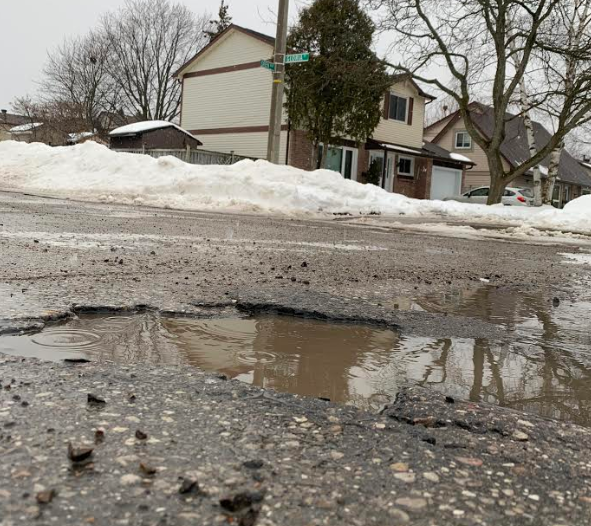A north-end Barrie resident says he has concerns about the use of asbestos in his decades-old street, but a top city official says there's no danger.
"Because the asbestos is bound within the pavement, there is very low risk to the public," Andrea Miller, the city's general manager of infrastructure and growth management, told BarrieToday.
Although not used in road construction anymore, research has since shown asbestos to be highly toxic and linked to cancer.
Gloria Street resident Dieter Mueller says his road is in "unbelievably poor condition" and he's concerned about what effect those small chunks he has discarded could have on the city landfill. Additionally, he says he worries about the resale value of his home. Mueller doesn't want to see these fears go unnoticed as the roadway continues to crumble.
While Mueller says he has been told the pavement is safe because the asbestos is permanently affixed to the asphalt, he says he worries about what happens as it breaks down.
"However, I have spoken to a professor from the University of Toronto, who has done research into asbestos-asphalt mix on roadways, and he says nothing is permanent," Mueller told BarrieToday, adding he believes the decades-old street has been "leaking" asbestos for a "very long time."
Since 1980, Mueller has lived on Gloria Street, which is a heavily cratered and pitted side street, even by Barrie's standards, a city which isn't exactly known for its silky smooth roads.
"It's in terrible condition," Mueller said. "You can even see it on the Google maps."
Mueller says for many years his street was a bus route.
"The bus roared up and down the road numerous times a day," he said, resulting in "extensive wear" on his street. "The road wore down very quickly."
Asbestos was used as an additive to asphalt from the 1960s to mid-1980s, Miller said.
"It was added to the asphalt mix to provide greater strength and performance," she said. "It is not used in asphalt anymore, but many municipalities with roads built from between the '60s and early '80s could contain asbestos."
Deputy Mayor Barry Ward, who oversees Ward 4 where Gloria Street is located, told BarrieToday that there is asbestos in many Barrie streets, and across North America, that were constructed around that time.
"City staff have told me in the past there is absolutely no health danger," Ward said.
The deputy mayor also points to numerous news articles which further indicate there's no danger.
This includes a situation in Toronto from 2012 when the city sent letters to residents asking them to stay indoors and close their windows while road resurfacing occurred outside. City officials noted there was "absolutely no health concern," but the notices were sent out "more out of an abundance of caution.”
Several news articles have been published over the years about workers wearing masks and hazardous materials suits to tear up streets in other cities where the asphalt contained asbestos.
Ward said "special challenges" do arise when trying to dispose of the old road material, however, when streets are repaved.
There is no timetable for when Gloria Street could get a makeover.
Before road construction or maintenance begins, the city first tests the asphalt for asbestos, Miller said. If the asphalt contains asbestos, special precautions are taken by the workers when removing the asphalt. Those precautions include wetting the asphalt to prevent the dust from becoming airborne and workers are required to wear proper protective equipment.
"Asphalt containing asbestos is not discarded at a landfill. Instead, it is taken to a provincially approved disposal site," Miller said of large-scale road projects.
There is provincial legislation specifically governing the disposal of asbestos from construction projects.
Mueller says he isn't only concerned for himself and people in his neighbourhood, but also the workers who are dispatched to fill the cracks in the road or clean the streets.
"They take compressed air and they blow out the cracks, which creates huge clouds of road dust which comes flying everywhere," he said. "Nobody on the team wears a hazmat suit and all of our neighbours are exposed to the result of that blown-up dust."
A self-proclaimed "neat freak," Mueller says he tries to keep his property and the area around it as clean as possible.
"When the potholes crumbled and there were chunks of asphalt, I would go and pick them up off the boulevard and throw them in the garbage," he said. "I didn't know they contained asbestos. It's not supposed to go in the garbage; it's supposed to go in with hazardous waste."
Around 1990, Mueller says he received a notice from the city that Gloria Street was to be repaved.
"And it never was," he said, adding other roads have been resurfaced in the neighbourhood.
Repaving Gloria Street will occur at some point, Miller said, but there's no firm date.
Some portions of Gloria Street, and other roads in the neighbourhood, have been identified as requiring road rehabilitation, she said.
"However, at this time there is no scheduled timeline," Miller added.
Resurfacing is determined based on assessing the condition of the city's entire road network to prioritize what needs to be done. The criteria includes traffic volume, road classification, where the road is in its life cycle, the value for money that the work could provide, and needs of subsurface infrastructure, Miller said.
"We review road conditions and determine rehabilitation locations every year based on need and available funding," she added.



